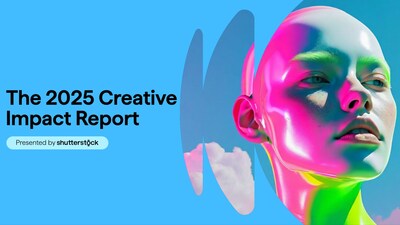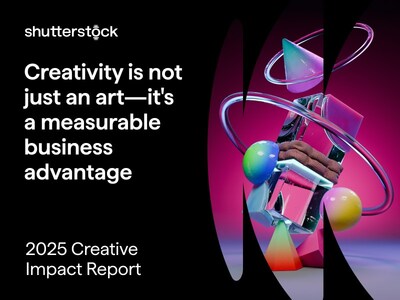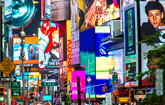
New 2025 Creative Impact Report finds global ad spend up 33% since 2023, while marketing impact drops nearly 20%, pointing to the need for creative quality, emotional acumen and AI to drive future growth
NEW YORK, Oct. 23, 2025 /PRNewswire/ -- Shutterstock, Inc. (NYSE: SSTK), a family of brands delivering scalable creative and GenAI solutions to help customers fuel great work, today released the results of the new 2025 Creative Impact Report: a proprietary research initiative that quantifies the business value of creativity. The study reveals a critical finding: between 2023 and 2024, marketing spend surged 33% while its impact on purchase intent only rose by 17%. This created a 12% 'impact gap,' which is quantified by the Impact Score—a proprietary metric that measures the true ROI of creative work. This year the negative trend has deepened, with the score showing a cumulative drop of nearly 20% from 2023 through August 2025.


The study, based on 44 months of econometrics modeling, AI-powered content analysis and proprietary creative trend data, tracked return on advertising spend (ROAS), purchase intent, trust, engagement scores and content virality and believability. Among the myriad takeaways, the data uncovers that volume-based marketing is failing in an era of content fatigue and cultural volatility. It also highlighted that creative quality, emotional connection, cultural relevance and AI-driven precision now outweigh budget size as key drivers of marketing success.
"Marketers know the answer isn't simply producing more content; it's unlocking how to make it more impactful," said Allison Sitzman, VP of Brand Strategy at Shutterstock. "The Creative Impact Report shows that creativity remains one of the most powerful growth levers in business—when used correctly. By understanding where impact is lost and how to close that gap, we're helping brands turn creativity into an engine for business results."
Three Strategies to Boost ROI
The 2025 Creative Impact Report identifies three strategies that define top performers:
- Lead with emotion. Campaigns evoking Pride and Belonging achieve believability scores above 61%. Anger drives the highest virality (42%) but erodes trust. Nostalgia is emerging as a powerful driver of credibility in turbulent times. Immersive formats such as AR/VR and branded GIFs can help strengthen emotional connections and purchase intent.
- Focus on fewer, high-impact messages. Believability drops after just three campaign messages. Multi-format campaigns built around a single, clear idea deliver 40% more ROI than single-format efforts.
- Push AI to amplify creativity. 56% of creatives note that AI enables them to make their work more emotionally relevant. When combined with human imagination, AI acts as a functional building block to translate the power of emotion and message focus with customization at scale, predictive trend analysis, and real-time adaptation to cultural shifts. This becomes a catalyst for campaigns that go beyond efficiency: delivering deeper resonance and measurable lifts in ROI.
Implications for 2026
The report finds 66% of businesses have faced boycotts tied to social movements, and nearly half acknowledge their creative processes lag behind cultural shifts. This gap leaves brands vulnerable to backlash when campaigns fail to lead with cultural relevance. Navigating this social minefield promises to continue into next year, where there will be unprecedented competition for attention and inventory as the Winter Olympics, FIFA World Cup and a record-breaking U.S. midterm election crowd the 2026 media landscape.
"The next era of marketing won't be won by volume, but by emotional and cultural intelligence," Sitzman added. "As we enter what will be the most crowded ad environment in history, the brands that break through won't be the ones shouting the loudest—they'll be the ones communicating with intent. Creativity is now a measurable business advantage, and the companies that harness it with emotional intelligence, cultural relevance, and AI-enabled personalization will close the gap between investment and impact."
Industry Winners and Losers
The report also breaks down performance by sector:
- Aerospace + Energy: +45% Impact Score, driven by high-value transactions and post-COVID travel resurgence.
- Automobile: -5%, showing resilience through EV transition storytelling.
- Consumer: -24%, the steepest decline, as inflation and competition erode impact.
- Technology: -12%, challenged by privacy changes and shifting from growth to efficiency.
- Pharmaceuticals: -1%, stable due to essential demand and sustained digital engagement.
The Bottom Line
The 2025 Creative Impact Report reveals that creative quality, rather than budget size, is now the primary driver of ROI. Brands that align emotional resonance with culturally relevant content and use AI to adapt in real time can close the 20% effectiveness gap and fuel trust, business growth and long-term competitive advantage.
For more information and to download the report, visit shutterstock.com/creative-impact-report.
About Shutterstock
Shutterstock is in the business of turning ideas into impact. Powered by a global network of millions of creators and our cutting-edge technology, we provide businesses, creatives and brand leaders with the essential, universal ingredients to make their work more effective. Shutterstock is home to the world's largest and most diverse collection of high-quality licensable assets, data and AI solutions, advertising and distribution solutions, exclusive editorial content, and full-service studio production—delivering unparalleled resources to fuel great work.
Discover our impact at www.shutterstock.com and connect with us on LinkedIn, Instagram, X, Facebook and YouTube.
SOURCE Shutterstock, Inc.







Share this article